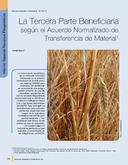Mostrar el registro sencillo del ítem
La Tercera Parte Beneficiaria según el Acuerdo Normalizado de Transferencia de Material
| dc.contributor.author | Moore, Gerald | |
| dc.date.accessioned | 2019-08-30T21:11:36Z | |
| dc.date.available | 2019-08-30T21:11:36Z | |
| dc.date.issued | 2008-04 | |
| dc.identifier.issn | ISSN: 1659-1216 | ISSN |
| dc.identifier.uri | https://repositorio.catie.ac.cr/handle/11554/9185 | |
| dc.description | 8 páginas, ilustrado, 11 referencias. | |
| dc.description.abstract | La noción de “la tercera parte beneficiaria” es uno de los elementos más innovadores del acuerdo normalizado de transferencia de material adoptado por el Órgano Rector del Tratado Internacional sobre los Recursos Fitogenéticos para la Alimentación y la Agricultura en su primera sesión en junio de 2006. Este concepto se desarrolló para tratar las circunstancias especiales del acuerdo normalizado de transferencia de material, mediante el cual los beneficios van al sistema multilateral y no a los proveedores individuales de germoplasma: en este sentido, los intereses a proteger son multilaterales, más que bilaterales. También ayuda a solucionar los problemas que enfrentan los países en vías de desarrollo para hacer cumplir las obligaciones inherentes a los contratos de transferencia de materiales de recursos genéticos. La aplicación del concepto a otros tipos de acuerdos de transferencia de material dependerá de que el interés que resulte de tales acuerdos pueda considerarse multilateral. | |
| dc.description.abstract | One of the most innovative elements of the standard material trans fer agreement adopted by the Governing Body of the International Treaty on Plant Genetic Resources for Food and Agriculture at its first session in June 2006 is the notion of the third party beneficiary. The concept of the third party beneficiary was devel oped to deal with the particular circumstances of the standard material transfer agreement, where benefits flow to the multilateral system rather to the individual providers of germplasm: in this sense, the interests to be protected are essentially multilateral rather than bilateral. It also helps to solve the perennial problem faced by developing countries of enforcing obligations under material transfer agree ments for genetic resources. Whether the concept can be extended to other types of material transfer agreement will depend on the extent to which interests arising under such agreements can properly be categorized as multilateral. | |
| dc.format.mimetype | ||
| dc.language.iso | es | es_ES |
| dc.publisher | CATIE, Turrialba (Costa Rica) | es_ES |
| dc.publisher | CATIE, Turrialba (Costa Rica) | |
| dc.relation.ispartof | Recursos Naturales y Ambiente Número 53 (Abril 2008), páginas 100-107 | |
| dc.rights | info:eu-repo/semantics/openAccess | es_ES |
| dc.rights | info:eu-repo/semantics/openAccess | |
| dc.rights.uri | https://creativecommons.org/licenses/by-nc-nd/4.0/ | |
| dc.subject | RECURSOS GENETICOS VEGETALES | |
| dc.subject | GERMOPLASMA | |
| dc.subject | CONSERVACION DEL GERMOPLASMA | |
| dc.subject | SEGURIDAD ALIMENTARIA | |
| dc.subject | ACUERDOS INTERNACIONALES | |
| dc.subject | LEGISLACION | |
| dc.subject | CONSERVACION | |
| dc.subject | GENETICA | |
| dc.subject | CONSERVACION DE LOS RECURSOS | |
| dc.subject | ACUERDOS | |
| dc.title | La Tercera Parte Beneficiaria según el Acuerdo Normalizado de Transferencia de Material | es_ES |
| dc.title.alternative | The Third Party Beneficiary under the Standard Material Transfer Agreement. | |
| dc.type | Artículo | es_ES |
| dc.journal.issueNumber | 53 | |
| dc.journal.pages | 100-107 |



